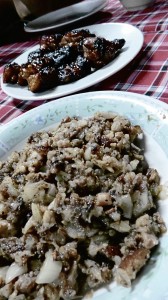
A trip to Pampanga means being spoiled with home-cooked delicacies, usually from heirloom recipes. The province is home to sisig, grilled crisp and chopped, or traditionally stewed in vinegar. There’s also bringhe, the Tagalog paella.
Pampanga is also a top source of cured meat like tocino and longganisa, which are perfect with runny eggs and garlic fried rice any time of day.
Samsung Electonics Philippines recently brought us on a Pampanga food tour to rediscover Kapampangan cooking. Members of the media also took food shots using the new Samsung Galaxy Camera. The 16.3-megapixel, 3G-capable and Wi-Fi-ready cam runs on Android Jelly Bean, which means food photos could easily be uploaded on social-networking sites—a practice very popular especially on Twitter and the Instagram photo-sharing app.
The itinerary was prepared by Outereater Tours and Events led by Poch Joloran, a true-blue Kapampangan and also the operations manager of Everybody’s Café, where we had breakfast.
Slow-cooked ‘morcon’
Everybody’s Café in San Fernando is a popular Pampanga restaurant that has been serving home-style dishes alongside exotic items since the ’60s.
For breakfast, we had scrambled eggs, longganisa and tapang kalabaw, which was surprisingly as tender as pork tocino.
Jorolan gave a tip on cooking longganisa: “If you want it extra sweet or hamonado, slice the longganisa first before frying so that it would caramelize.”
Restaurant owner Beth Jorolan, Poch’s mom, then served us slow-cooked morcon with quezo de bola and chorizo. The morcon is a smooth and tasty meat loaf cooked for hours; the drippings are made into a rich sauce meant to be slathered on the slices.
It was barely 10 a.m. but we already had a taste of the exotic with a serving of adobong kamaro or crickets with a woody taste. Another novel dish is Kilayin, pork meat and liver braised in vinegar à la adobo.
Our next stop was the home of Lillian Borromeo in Mexico. She is a cookbook author famous for making San Nicolas and dulce prenda cookies. According to Borromeo, these sweet treats were introduced by Chinese bakers in 1600s.
She showed how to make cookies from a dough made of butter, sugar, coconut milk, pork lard, cornstarch, uraro flour, baking powder and dayap rind. Borromeo said uraro flour spells the difference between store-bought butter cookies and San Nicolas cookies. It comes from processing arrow root, a ginger-like root crop.
Dulce prenda, meanwhile, are cookies filled with minatamis na kondol or sweetened wintermelon.
(San Nicolas cookies are sold at P200 per box of 12; dulce prenda is P300 per box of 12. Call tel. 0915-7730788.)
Alviz farm
Tucked in the suburbs of Santa Rita is a secret hideaway: Alviz Farm.
In the center of the sprawling farm is a wood-and-capiz country house overlooking a fish pond and rice fields. Home owner and cook Celi Alviz explained that the place was intended as a family rest house, a venue for gatherings.
“But our guests enjoyed what we served and, through word of mouth, visitors, mostly from Manila, started to book for destination breakfast and lunch,” Alviz said.
It is easy to understand why. Our lunch started with fresh labanos and tomato salad with vinaigrette dressing. This was followed by hearty nilagang manok soup, a cross between sinigang and tinola. The soup is made sweet with sliced corn and spiked with some sili leaves.
We also had pork asado and grilled tilapia, all downed with a refreshing glass of pandan-lemongrass iced tea.
The farm may be booked for events for a maximum of 100 guests. Small groups may also avail themselves of the breakfast buffet, which is a spread of tamales with pan de sal, tuyo with eggplant, dinuguan with puto, longganisa, tocino and daing na bangus; and fresh carabao’s milk. This is at P500 per head, for a minimum of 10 diners.
Other specialties are sisig and bringhe with yellow ginger or dilaw.
(Call tel. 0906-4491151 or e-mail araceli_alviz@gmail.com.)
‘Pasalubong’
A trip would not be complete without pasalubong. So we took a side trip to Sta. Rita to visit a house that doubles as a turones factory. Ramon Ocampo told us his family has been making
In another home, May Mercado demonstrated how to make barquillos. The batter, made of carabao’s milk, duck eggs, rice flour and dayap, is pressed into a customized crepe-maker and rolled using an iron stick.
A spin-off of the barquillos is barquiron, or barquillos filled with polvoron.
Mercado served us patku for merienda, local crepe filled with ground young coconut and wrapped in banana leaves.
At the end of a hot day on the road, a tall glass of creamy halo-halo was just appropriate. We dropped by Cabigting’s in Robinson’s Starmills to try out its best-selling white halo-halo. Among the ingredients are pastillas de leche, mashed beans and cream of corn, generously topped with shaved ice and evaporated milk.
Our last stop was Mely’s, an al fresco grill which serves sisig, chicken-tail barbecue and cold beer. Over dinner, Jorolan explained that he started the food tour to educate people on the richness of Kapampangan cooking and culture. Pampanga, after all, is frequently referred to as the “culinary capital of the Philippines.”
Food photos shared online helps a lot, too, he said. With Samsung Galaxy Cam’s Smart Pro Mode and 21X optical zoom lens, uploaded shots of sisig and halo-halo are sure to make anyone crave for Kapampangan novelties.
Call Outereater at tel. 0999-994 8634.
Visit www.samsung.com/ph.
PHOTOS BY IRENE C. PEREZ